Animal Kindness as part of our values
Against the backdrop of uncertainty and inequality, we set out to reconsider the relationship between humans and animals.
Previously it would be expected that organisations like the RSPCA and Scottish SPCA would highlight the connections between humans, animals and their environment.
But we must build on - and go beyond - our former efforts, because our individual and collective livelihoods, and the future we offer the next generation demand it.
The results of our first-ever Animal Kindness Index show that times have changed. The public recognises the interdependencies between humans, animals and the natural environment and desires change - the idea of 'one welfare' is gaining traction.
Supporting that change is the RSPCA's core mission.
"The RSPCA's vision is a world where all animals are respected and treated with kindness and compassion. Our mission is to ensure animals have a good life by rescuing and caring for those in need, by advocating on behalf of all animals and by inspiring everyone to treat them with compassion and respect."
This vision responds to a wider global shift in attitudes towards animal welfare despite or perhaps because of social, economic and environmental upheaval.
Scottish SPCA has also changed their vision to reflect this evolving view of animal welfare, wanting a world in which:
"Every animal has a good life. Every person embraces the joy and value animals add to our lives, and recognises they have feelings and needs which should be met."
Animal welfare is a mainstream issue. A generational shift has occurred where there is not only dislike towards cruelty to animals, but recognition and understanding that animals feel pain and experience emotions. The connections between animals, humans and the environment are widely appreciated.
In the RSPCA's recently published essay collection, What Have Animals Ever Done For Us, RSPCA CEO Chris Sherwood asks us to consider our responsibilities in cohabiting the earth with millions of species at a time where demand for natural resources is increasing. The challenge is real:
"With great power, comes great responsibility, and we have developed the capacity to determine not merely our own fate but that of millions of other individual species, trillions of individual animals trying to live alongside us."
Individuals are willing to take that responsibility and urge Governments across the UK to do the same.
Revealing that a vast majority of people across the UK love animals and value animals' wellbeing, this unique insight also shows that at times, there is a gap between our intentions and behaviour.
Many want change, with animal welfare a high priority. But they can't always translate that desire into their own actions or influence their families, friends, the Government or businesses to act accordingly.
This type of gap is not uncommon.
It may be the case that a lack of opportunity, means or information, in a fast paced, 24-hour media world, makes acting on our beliefs hard. It may be the case that at a time of immense pressure on household budgets, people are managing priorities that seem to conflict.
Knowing the desire to change is there provides the foundation to build a better understanding of our decision-making. What motivates individuals, businesses and government? And what can be done to create genuine and sustainable change?
For us at the RSPCA and Scottish SPCA this translates into working:
"To change attitudes and behaviours by supporting, encouraging and inspiring better informed, kinder and compassionate individuals and communities... so we can adapt our work to focus our efforts where they are most needed and improve the public's and others' understanding of animals and their welfare."
The following report provides a snapshot, a point in time to understand some of the values people hold on animal welfare. The findings lead to clear action for individuals, businesses and government.
Action that can be taken now, such as:
There is indeed an opportunity to reset and better understand collective challenges and potential solutions. It is an opportunity to recalibrate together the society we want to live in.
As Scottish SPCA CEO, Kirsteen Campbell, says, "Animals are facing unprecedented challenges. Partners, individuals and communities across the country must be empowered, with our support, to take ownership of protecting the companion, wild and farmed animals in their lives."
We stand at 'a pivotal moment', where we have choices about how we as individuals, families, businesses and Government define the relationships that exist between human and animals now and for the future.
This first Animal Kindness Index is a step on that journey.
In total, 4,102 UK adults were surveyed using an online methodology.
The sample was then weighted to be representative of the UK population aged 18 and above. Fieldwork was conducted between the 13th and 25th April 2022.
In addition to this polling work, we have drawn on resources across the RSPCA and Scottish SPCA to provide a deeper understanding. We also analysed Google search data to look at people's search behaviour in the UK over the last 3 years, looking at volumes, trends and common phrases searched.
Previously it would be expected that organisations like the RSPCA and Scottish SPCA would highlight the connections between humans, animals and their environment.
But we must build on - and go beyond - our former efforts, because our individual and collective livelihoods, and the future we offer the next generation demand it.
The results of our first-ever Animal Kindness Index show that times have changed. The public recognises the interdependencies between humans, animals and the natural environment and desires change - the idea of 'one welfare' is gaining traction.
Supporting that change is the RSPCA's core mission.
"The RSPCA's vision is a world where all animals are respected and treated with kindness and compassion. Our mission is to ensure animals have a good life by rescuing and caring for those in need, by advocating on behalf of all animals and by inspiring everyone to treat them with compassion and respect."
This vision responds to a wider global shift in attitudes towards animal welfare despite or perhaps because of social, economic and environmental upheaval.
Scottish SPCA has also changed their vision to reflect this evolving view of animal welfare, wanting a world in which:
"Every animal has a good life. Every person embraces the joy and value animals add to our lives, and recognises they have feelings and needs which should be met."
Animal welfare is a mainstream issue. A generational shift has occurred where there is not only dislike towards cruelty to animals, but recognition and understanding that animals feel pain and experience emotions. The connections between animals, humans and the environment are widely appreciated.
In the RSPCA's recently published essay collection, What Have Animals Ever Done For Us, RSPCA CEO Chris Sherwood asks us to consider our responsibilities in cohabiting the earth with millions of species at a time where demand for natural resources is increasing. The challenge is real:
"With great power, comes great responsibility, and we have developed the capacity to determine not merely our own fate but that of millions of other individual species, trillions of individual animals trying to live alongside us."
Individuals are willing to take that responsibility and urge Governments across the UK to do the same.
Revealing that a vast majority of people across the UK love animals and value animals' wellbeing, this unique insight also shows that at times, there is a gap between our intentions and behaviour.
Many want change, with animal welfare a high priority. But they can't always translate that desire into their own actions or influence their families, friends, the Government or businesses to act accordingly.
This type of gap is not uncommon.
It may be the case that a lack of opportunity, means or information, in a fast paced, 24-hour media world, makes acting on our beliefs hard. It may be the case that at a time of immense pressure on household budgets, people are managing priorities that seem to conflict.
Knowing the desire to change is there provides the foundation to build a better understanding of our decision-making. What motivates individuals, businesses and government? And what can be done to create genuine and sustainable change?
For us at the RSPCA and Scottish SPCA this translates into working:
"To change attitudes and behaviours by supporting, encouraging and inspiring better informed, kinder and compassionate individuals and communities... so we can adapt our work to focus our efforts where they are most needed and improve the public's and others' understanding of animals and their welfare."
The following report provides a snapshot, a point in time to understand some of the values people hold on animal welfare. The findings lead to clear action for individuals, businesses and government.
Action that can be taken now, such as:
- Animal welfare to be part of schools' curriculum to nurture the relationships between young people and animals. The UK and devolved Governments in Wales, Scotland, and Northern Ireland should lead this.
- The RSPCA and Scottish SPCA and our members will continue to support our pet food bank scheme and other initiatives to help the public with high food costs and reduce animal abandonment.
- Businesses should focus on the value of 'the animal pound' to offer their customers the opportunity to act on their values on animal welfare and sustainability and meet their expectations.
- With our supporters, the RSPCA and Scottish SPCA will continue to push Governments to press forward with animal welfare legislation to meet the aspirations of citizens.
There is indeed an opportunity to reset and better understand collective challenges and potential solutions. It is an opportunity to recalibrate together the society we want to live in.
As Scottish SPCA CEO, Kirsteen Campbell, says, "Animals are facing unprecedented challenges. Partners, individuals and communities across the country must be empowered, with our support, to take ownership of protecting the companion, wild and farmed animals in their lives."
We stand at 'a pivotal moment', where we have choices about how we as individuals, families, businesses and Government define the relationships that exist between human and animals now and for the future.
This first Animal Kindness Index is a step on that journey.
Methodology
The RSPCA commissioned YouGov to conduct a nationally representative survey looking at attitudes and awareness among the British public towards animal welfare. This would build on previous research and provide a snapshot of how warmly the UK population feels towards animals at this time.In total, 4,102 UK adults were surveyed using an online methodology.
The sample was then weighted to be representative of the UK population aged 18 and above. Fieldwork was conducted between the 13th and 25th April 2022.
In addition to this polling work, we have drawn on resources across the RSPCA and Scottish SPCA to provide a deeper understanding. We also analysed Google search data to look at people's search behaviour in the UK over the last 3 years, looking at volumes, trends and common phrases searched.
The UK is a nation of animal lovers
Over two-thirds (69%) of respondents - an estimated 36 million people across the UK - describe themselves as animal lovers.
26% of respondents are neutral about animals and 3% answered that they actively do not like them (Figure 1).
Figure 1: How respondents feel about animals
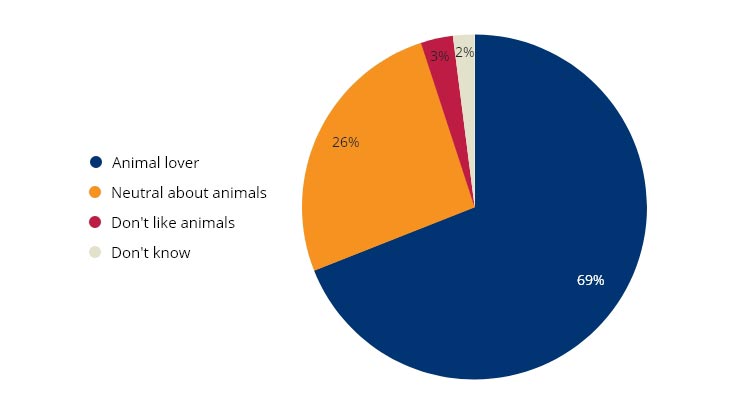
In addition, there is overwhelming support from the public that animals should not be used in ways that cause harm.
When presented with a range of statements about the relationships between humans and animals, the most common answer selected was that 'humans should never use animals in ways that cause them harm for any reason', chosen by 46% of respondents.
This is followed by 'humans should only use animals in ways that cause them harm where there is no feasible alternative and where there is a benefit to human wellbeing', chosen by 35% of respondents.
Combined, these two groups represent four out of five members (80%) of the UK public, who do not believe we should use animals in ways that cause them harm, or only when there is no feasible alternative and benefit to humans.
People also ranked animal welfare as one of their top three concerns - behind mental health and the environment - when considering a range of social and environmental issues.
This demonstrates that together with other issues, animal welfare is significant in the minds of the British public. (Figure 2)
Figure 2: Causes that are important to the British public (respondents could choose up to three options)
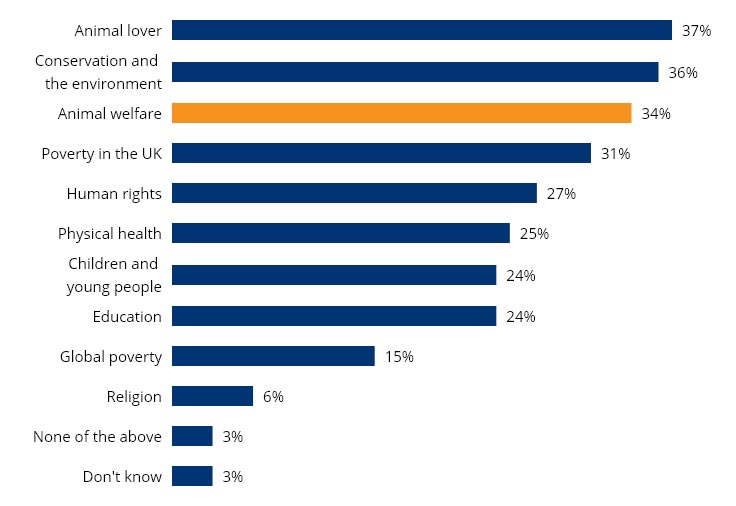
When examining the data on attitudes towards animal welfare, a profile emerges of the kind of person who is most concerned about animal wellbeing. This is based on responses to questions on:
Figure 3: Attitudes to animal welfare by gender
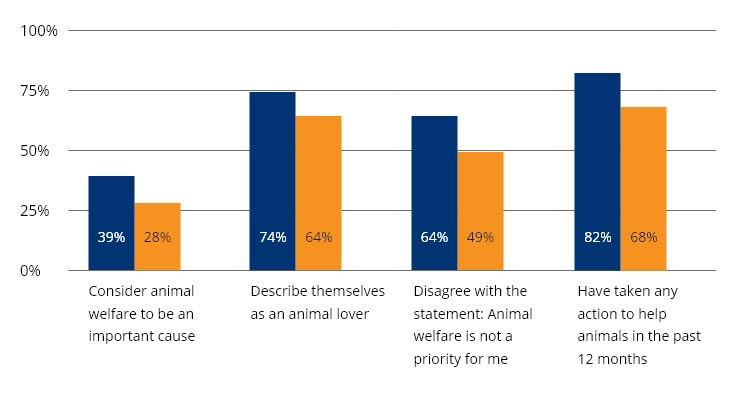
Another demographic difference evident in the results is age, with older respondents more supportive of improving animal welfare than younger respondents, especially when compared to the youngest age group of those aged 18 to 24. For example, the proportion of those who have taken action to help animals in the past 12 months increases from 66% of those aged 18 to 24 to 72% of those aged 35 to 44 and then 81% of those aged 55 and above. Similarly, 59% of those aged 18 to 24 describe themselves as an animal lover compared with 75% of those aged 45 to 54 (Figure 4).
Figure 4: Attitudes towards animal welfare by age group
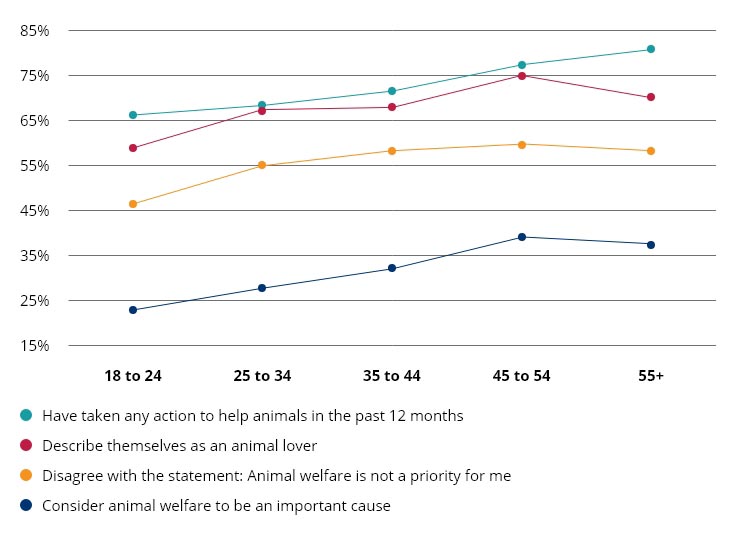
These results suggest that women and older respondents are more interested in animal welfare and are therefore more likely to be open to taking action to help protect animals.
The actions were diverse, from providing directly for animals such as feeding the birds (50%), or creating a habitat for wildlife (31%); to supporting animal charities by either donating or buying something (35%); to making dietary choices, such as eating less meat/stopping eating meat (31%) or buying products with higher animal welfare standards (23%) (Figure 5).
Unsurprisingly it was those who said they were animal lovers, pet owners and women who were more likely to have taken action in the past year.
Figure 5: Actions taken to help animals in the past 12 months
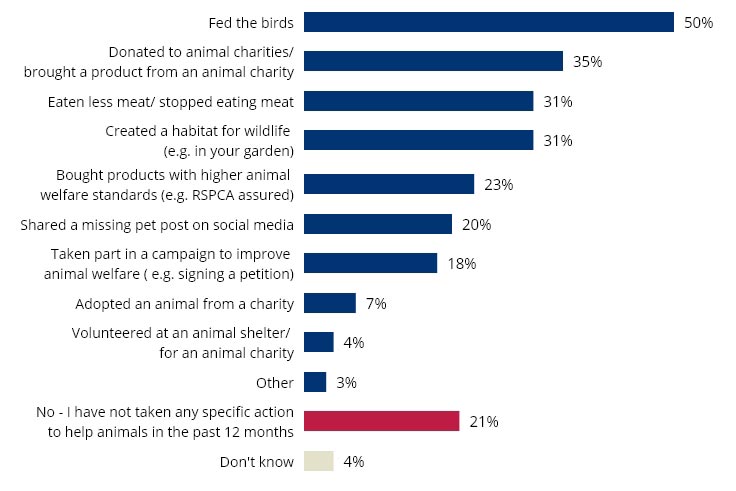
High levels of active participation are also reflected in the high proportion of respondents (78%) who also said that individuals were responsible for animal welfare (Figure 6).
Two-thirds (65%) consider the UK Government to be responsible for animal welfare. This is more than believe it is the responsibility of non-government organisations (NGOs) and charities (49%).
In Scotland, 70% think it is the responsibility of the Scottish Government with the same proportion believing it is the responsibility of the UK Government.
In Wales, 64% see it as the responsibility of the Welsh Government with more respondents in Wales thinking the UK Government is responsible 75%.
Figure 6: Who is responsible for animal welfare (respondents could choose multiple options)
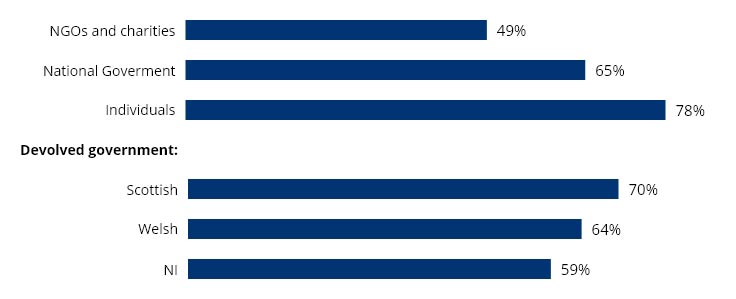
The vast majority think the Government should legislate to protect animals
Over four in five people (81%) think that animal welfare should be protected by the Government through legislation. (Figure 7)
Within this, many (45%) strongly agree with the statement that animal welfare should be protected by the government through legislation.
Figure 7: Animal welfare should be protected by the government through legislation
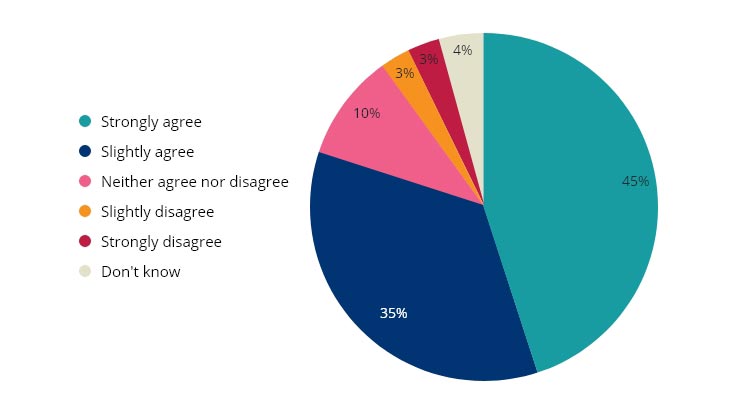
With many aspects of animal welfare devolved to national governments, there are some differences between the countries of the UK.
Those in Wales are especially likely to agree compared with the other nations of the UK. 90% of Welsh respondents agreed, compared to 80% of those in England, 82% of those in Scotland and 78% of those in Northern Ireland.
The public have demonstrated a clear expectation that animal welfare should be protected by the Scottish Government, the Welsh Government and the UK Government.
A significant majority want confidence that animal welfare won't be left behind and will be taken seriously by the Government across the UK.
But there is currently a gap between the public's expectations and the regulatory framework. The public's expectation that animal welfare should be taught in schools is an example that highlights this gap.
Most people (84%) agree that animal welfare should be taught in schools. This is an increase from 2018 when 78% of people were in support.
Education is devolved in England, Wales, Scotland and Northern Ireland, and support for animal welfare in schools is strong across all of these nations (Figure 8)
Figure 8: Agreement with whether animal welfare should be taught in schools by nation
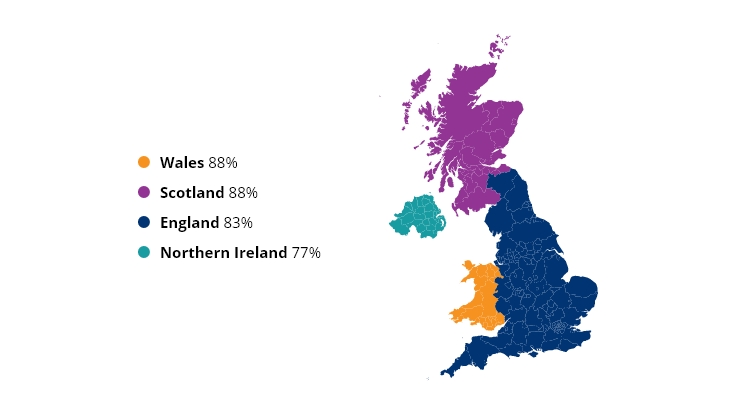
Drawing on the strength of this public support, the RSPCA and Scottish SPCA aims to re-energise our ambition to see animal welfare included in the curriculum. And we are optimistic. In England, the Personal, Social, Health and Economic (PSHE) curriculum is evolving, continuously responding to the needs of our young people growing up, with areas such as financial literacy, first aid and relationships and sex education having been added - and we hope to see animal welfare there too. In Wales, the new curriculum's 'Areas of Learning and Experience' will offer a great opportunity to teach school children about empathy, compassion and animals.
Teaching animal welfare can help students learn about empathy, make more informed choices when shopping for food and other products and foster concern for animal welfare. Research conducted by Scottish SPCA and University of Edinburgh shows that by teaching animal welfare you can help a child to develop positive attitudes towards animals and influence a child's belief that animals have feelings.
Learning how to care for dogs, for example, can further contribute to dogs' wellbeing and human safety. Through our facial expressions, emotions and behaviours, dogs know what we're feeling. Nurturing these relationships between children and animals is of mutual benefit.
Figure 9: UK Government's treatment of animals
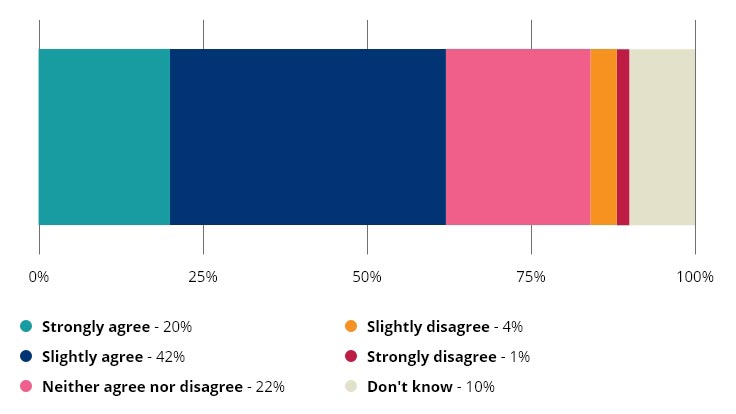
In some cases that may be true. But in other cases, progress is sluggish, significantly lagging behind other nations.
The RSPCA recently published a scorecard on the Government's first anniversary of the Action Plan for Animals. Progress is too slow, with only three out of the 39 promises successfully completed into law. Nineteen areas have completely stalled.
As David Bowles, the RSPCA's Head of Public Affairs said:
"We welcomed the Government's plan last year as it addressed issues we had been campaigning on for some time and these changes could make a real and lasting difference to animal welfare, but we're disappointed that one year on little progress has been made in crucial areas.
We're pleased that the Animal Welfare (Sentience) Act has been completed along with the Glue Traps Act and we welcome the announcement of subsidy payments for farmers who farm to higher welfare standards but that is where the good news stops. There are 19 important areas that have sadly seen no movement."
The Animal Protection Index scorecard provides a comparative assessment of the UK's legislative environment compared to other areas. In areas such as protecting animals used in farming and protecting animals used for drought and recreation, the UK lags behind certain other countries. One example is the use of hen cages in farming, still permitted in the UK, but banned, or due to be banned, in Austria, Luxembourg and Germany.
Our supporters continuously raise campaign issues that further expose this gap. A recent petition signed by over 100,000 members of the public calls on the UK Government to better protect the reducing hedgehog population. And we receive queries from the public, who are surprised that an iconic species like the brown hare is not protected and can be shot by farmers to protect their crops, urging us to campaign for change.
26% of respondents are neutral about animals and 3% answered that they actively do not like them (Figure 1).
Figure 1: How respondents feel about animals

In addition, there is overwhelming support from the public that animals should not be used in ways that cause harm.
When presented with a range of statements about the relationships between humans and animals, the most common answer selected was that 'humans should never use animals in ways that cause them harm for any reason', chosen by 46% of respondents.
This is followed by 'humans should only use animals in ways that cause them harm where there is no feasible alternative and where there is a benefit to human wellbeing', chosen by 35% of respondents.
Combined, these two groups represent four out of five members (80%) of the UK public, who do not believe we should use animals in ways that cause them harm, or only when there is no feasible alternative and benefit to humans.
People also ranked animal welfare as one of their top three concerns - behind mental health and the environment - when considering a range of social and environmental issues.
This demonstrates that together with other issues, animal welfare is significant in the minds of the British public. (Figure 2)
Figure 2: Causes that are important to the British public (respondents could choose up to three options)

When examining the data on attitudes towards animal welfare, a profile emerges of the kind of person who is most concerned about animal wellbeing. This is based on responses to questions on:
- describing themselves as an animal lover
- considering animal welfare to be an important cause
- prioritising animal welfare
- taking action to support animals.
Figure 3: Attitudes to animal welfare by gender

Another demographic difference evident in the results is age, with older respondents more supportive of improving animal welfare than younger respondents, especially when compared to the youngest age group of those aged 18 to 24. For example, the proportion of those who have taken action to help animals in the past 12 months increases from 66% of those aged 18 to 24 to 72% of those aged 35 to 44 and then 81% of those aged 55 and above. Similarly, 59% of those aged 18 to 24 describe themselves as an animal lover compared with 75% of those aged 45 to 54 (Figure 4).
Figure 4: Attitudes towards animal welfare by age group

These results suggest that women and older respondents are more interested in animal welfare and are therefore more likely to be open to taking action to help protect animals.
Individuals taking responsibility
Translating some of this into action, in the last 12 months, three-quarters of people had taken action to help animals. This equates to approximately 39 million people and provides a strong indication that the majority of people care about animals.The actions were diverse, from providing directly for animals such as feeding the birds (50%), or creating a habitat for wildlife (31%); to supporting animal charities by either donating or buying something (35%); to making dietary choices, such as eating less meat/stopping eating meat (31%) or buying products with higher animal welfare standards (23%) (Figure 5).
Unsurprisingly it was those who said they were animal lovers, pet owners and women who were more likely to have taken action in the past year.
Figure 5: Actions taken to help animals in the past 12 months

High levels of active participation are also reflected in the high proportion of respondents (78%) who also said that individuals were responsible for animal welfare (Figure 6).
Expectations of the Government
People are willing to take individual responsibility, but a large proportion of respondents consider animal welfare to be the responsibility of the Government (Figure 6 - where respondents could choose multiple options).Two-thirds (65%) consider the UK Government to be responsible for animal welfare. This is more than believe it is the responsibility of non-government organisations (NGOs) and charities (49%).
In Scotland, 70% think it is the responsibility of the Scottish Government with the same proportion believing it is the responsibility of the UK Government.
In Wales, 64% see it as the responsibility of the Welsh Government with more respondents in Wales thinking the UK Government is responsible 75%.
Figure 6: Who is responsible for animal welfare (respondents could choose multiple options)

The vast majority think the Government should legislate to protect animals
Over four in five people (81%) think that animal welfare should be protected by the Government through legislation. (Figure 7)
Within this, many (45%) strongly agree with the statement that animal welfare should be protected by the government through legislation.
Figure 7: Animal welfare should be protected by the government through legislation

With many aspects of animal welfare devolved to national governments, there are some differences between the countries of the UK.
Those in Wales are especially likely to agree compared with the other nations of the UK. 90% of Welsh respondents agreed, compared to 80% of those in England, 82% of those in Scotland and 78% of those in Northern Ireland.
The public have demonstrated a clear expectation that animal welfare should be protected by the Scottish Government, the Welsh Government and the UK Government.
A significant majority want confidence that animal welfare won't be left behind and will be taken seriously by the Government across the UK.
But there is currently a gap between the public's expectations and the regulatory framework. The public's expectation that animal welfare should be taught in schools is an example that highlights this gap.
Animal welfare should be taught in schools
There is overwhelming support that animal welfare should be part of the school curriculum.Most people (84%) agree that animal welfare should be taught in schools. This is an increase from 2018 when 78% of people were in support.
Education is devolved in England, Wales, Scotland and Northern Ireland, and support for animal welfare in schools is strong across all of these nations (Figure 8)
Figure 8: Agreement with whether animal welfare should be taught in schools by nation

Drawing on the strength of this public support, the RSPCA and Scottish SPCA aims to re-energise our ambition to see animal welfare included in the curriculum. And we are optimistic. In England, the Personal, Social, Health and Economic (PSHE) curriculum is evolving, continuously responding to the needs of our young people growing up, with areas such as financial literacy, first aid and relationships and sex education having been added - and we hope to see animal welfare there too. In Wales, the new curriculum's 'Areas of Learning and Experience' will offer a great opportunity to teach school children about empathy, compassion and animals.
Teaching animal welfare can help students learn about empathy, make more informed choices when shopping for food and other products and foster concern for animal welfare. Research conducted by Scottish SPCA and University of Edinburgh shows that by teaching animal welfare you can help a child to develop positive attitudes towards animals and influence a child's belief that animals have feelings.
Learning how to care for dogs, for example, can further contribute to dogs' wellbeing and human safety. Through our facial expressions, emotions and behaviours, dogs know what we're feeling. Nurturing these relationships between children and animals is of mutual benefit.
Education is not the only gap between the public's wishes and Government action
Almost two-thirds of people (63%) in the survey agreed that the UK treats animals better than other countries do, with one-fifth (20%) strongly agreeing (Figure 9). This suggests that many perceive the UK to have higher welfare standards compared to other countries.Figure 9: UK Government's treatment of animals

In some cases that may be true. But in other cases, progress is sluggish, significantly lagging behind other nations.
The RSPCA recently published a scorecard on the Government's first anniversary of the Action Plan for Animals. Progress is too slow, with only three out of the 39 promises successfully completed into law. Nineteen areas have completely stalled.
As David Bowles, the RSPCA's Head of Public Affairs said:
"We welcomed the Government's plan last year as it addressed issues we had been campaigning on for some time and these changes could make a real and lasting difference to animal welfare, but we're disappointed that one year on little progress has been made in crucial areas.
We're pleased that the Animal Welfare (Sentience) Act has been completed along with the Glue Traps Act and we welcome the announcement of subsidy payments for farmers who farm to higher welfare standards but that is where the good news stops. There are 19 important areas that have sadly seen no movement."
The Animal Protection Index scorecard provides a comparative assessment of the UK's legislative environment compared to other areas. In areas such as protecting animals used in farming and protecting animals used for drought and recreation, the UK lags behind certain other countries. One example is the use of hen cages in farming, still permitted in the UK, but banned, or due to be banned, in Austria, Luxembourg and Germany.
Our supporters continuously raise campaign issues that further expose this gap. A recent petition signed by over 100,000 members of the public calls on the UK Government to better protect the reducing hedgehog population. And we receive queries from the public, who are surprised that an iconic species like the brown hare is not protected and can be shot by farmers to protect their crops, urging us to campaign for change.
Capitalising on the desire for change
The drive for change is clear. People are taking more responsibility, acting to help animals and show a strong desire for the Government to also step up. Including animal welfare in the school curriculum, as an example, would be easy and transformative. It would respond to the large proportion of the population demanding action on animal welfare.The cost of living
Increases to the cost of living continue to ripple through society and will for some time to come.
Under immense pressure, the UK Government announced a £15 billion package of support for households to cope with rising living costs in May 2022. The package will certainly provide temporary relief and timely support for many households faced with significant hardship, the Institute for Fiscal Studies (IFS) says, but income and spending volatility remains the norm for too many.
Although the Government's package aims to curb the sharp increases in day-to-day household costs, there remain underlying challenges of rising child poverty rates, increase in food bank use and demand for debt support services outstripping supply.
Many households don't have enough savings to withstand a financial shock, for example coping with a family illness, changes in working hours or even a washing machine breaking down.
And it is within this context that we are concerned about the welfare of animals.
Our polling work took place just before the Government's relief package was announced and paints a worrying picture.
(Figure 10). In reality that means that costs have increased for an estimated 18.5 million pet owners.
For about half of these pet owners (52%), it is slightly more expensive; but for 16% it is much more expensive. A quarter (26%) say there is no difference and a small minority (2%) find it less expensive.
Figure 10: How the cost of looking after their pet has changed in the past 12 months
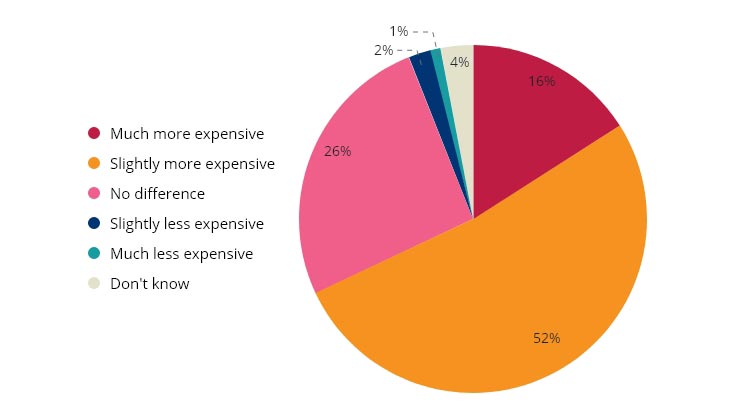
These increased expenses directly translate into concerns about pet owners looking after and feeding pets (Figure 11).
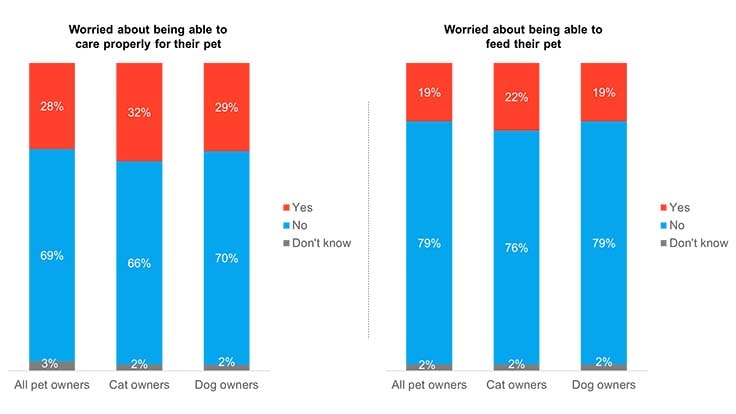
Responding to concern over being able to feed and take care of pets, we began joining forces with local food banks in 2020.
Thanks to a generous donation by the Pets At Home Foundation in 2022, we've been able to extend this to help even more pet owners who are struggling.
Building on existing schemes run by many RSPCA centres and branches, the new Pet Food Bank Partnership sees over 20 more teaming up with their local food banks across the north of England. The scheme aims to reach 110 food banks by the end of next year to provide help to the public and reduce animal abandonment. In the first quarter of 2022, the RSPCA distributed double the amount of pet food than the previous year to help meet demand.
So far this year, between January and May, the partnership has delivered over 100 pet food bundles to its food banks across the north of England, including 51 in Lancashire (where the project began). But more food is now desperately needed.
Understandably, concern about cost and looking after pets is linked to income.
Those in lower household income bands are more likely to be worried compared to those in the higher income bands.
Almost two-fifths (39%) of those with a household income of under £20,000 a year are worried about being able to care properly for their pet compared to just under one-fifth (18%) of those with a household income of £60,000 and above.
Ways to reduce the costs of having a pet generate persistently high volumes of searches. The most frequent of these searches is around pet vaccination costs (Figure 12).
Overall there has been a steady upwards trend, peaking in August 2021, with over 23,000 searches a month for pet vaccination costs. In 2022, the average is about 17,000, far higher than volumes pre-pandemic in 2019.
Figure 12: Pet vaccination costs
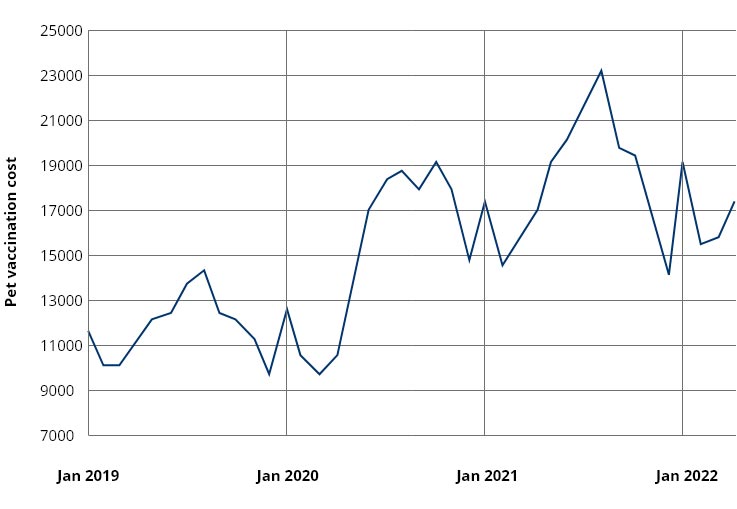
A similar trend, although with lower volumes, is found with the search term 'cheap vets near me' (Figure 13).
Before coronavirus, in 2019, this term had an average of 2,350 searches a month. Search volumes rose with a significant spike in the summer 2021 where there were more than 5,000 monthly searches. So far in 2022, searches have been more steady, averaging at about 3,330 per month.
Figure 13: Cheap vets near me
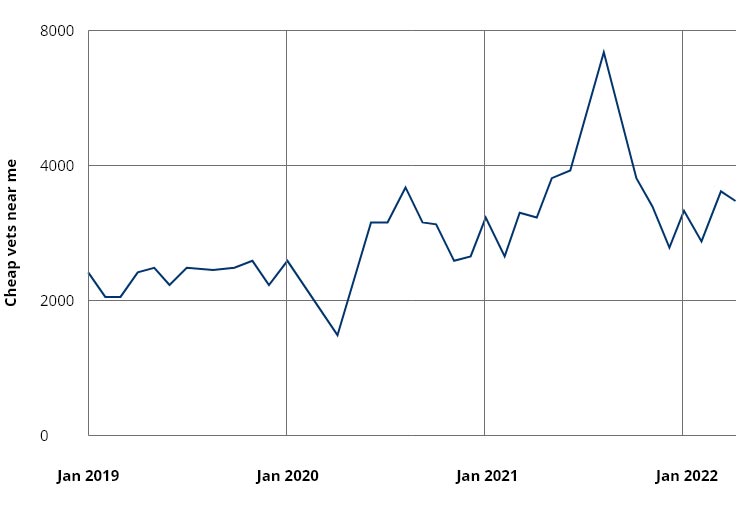
Linked to searches seeking help for sick animals, we have also seen a sensational rise in Google searches for terms such as 'can I give my dog paracetamol', suggesting that people are trying to treat their pets at home (Figure 14). In 2019, before coronavirus, the average number of monthly searches were 15,753. By 2021, the average number of monthly searches had more than doubled to over 35,000 per month. In April 2022, there were a staggering 39,840 searches - the highest recorded to date.
Figure 14: Can I give my dog paracetamol?
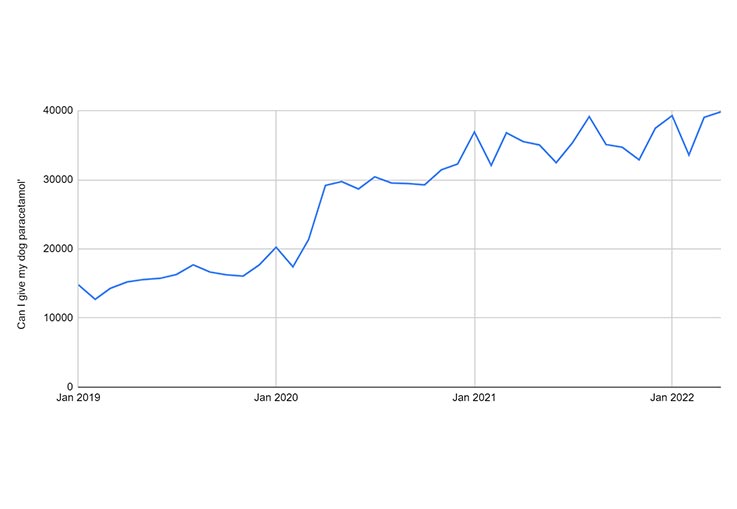 Increases in these kinds of searches also point to people accessing varied information. Although the most common place for pet owners to seek advice from is vets, survey data also found that about half looked online (49%) when seeking advice and information; with 44% looking online in general and 12% looking on social media. Again this raises concern that many may be pushed through to information of mixed quality and may not always receive the most accurate information or advice.
Increases in these kinds of searches also point to people accessing varied information. Although the most common place for pet owners to seek advice from is vets, survey data also found that about half looked online (49%) when seeking advice and information; with 44% looking online in general and 12% looking on social media. Again this raises concern that many may be pushed through to information of mixed quality and may not always receive the most accurate information or advice.
Another noticeable rise has been for help with vet bills. In April 2020, there were approximately 4,000 monthly searches for related terms. So far in 2022 there are just under 6,000 a month. Nearly 600 of these are specifically looking for RSPCA support with bills; and another 600 explicitly look for help with vet bills on benefits. This is consistent with call volumes to our emergency and cruelty line where in 2021 the RSPCA received 3,644 calls categorised as 'help with vet bills'.
This is an increase of 12% from the year before where 3,241 calls were received.
Presenting search data can lead to a number of different interpretations. It could be that the data presented simply reflect new pet owners getting to grips with their new responsibilities; but combined with other findings from the survey, we are concerned that they are an indication of struggles to afford what pets need to thrive.
In the polling results, approximately a third of pet owners found something surprising about looking after a pet. The most common surprises were restrictions on personal freedom, cited by about a third (34%), or unexpected behavioural issues, cited by over a quarter (27%).
Dog owners are especially likely to say that they found the restrictions on personal freedom to be more than they expected; and are also likely to say that behavioural issues have been more difficult compared to other pet owners.
These findings are in tension with other survey results that point to a large number of people recognising that dogs feel and express emotions (Figure 20), and sentiments from the RSPCA's Dogkind report where again there were high levels of people recognising the range of emotions that dogs feel, but challenges for dog owners to translate those attitudes into positive pet-owning behaviour.
The difficulties in translating attitudes into behaviours then as now are most likely to be because owners are busy, have a lack of awareness of what to do, or the cost of seeking solutions can be a hurdle or prohibitive. It is possible that as the lockdown eased, activities like walking and spending time with a dog became more difficult with the return of going to work.
Another way to explore the mismatch of expectations is to look at information on buying and rehoming animals.
Lockdown puppies and kittens
Not long ago, images of lockdown puppies and kittens flooded social media and family WhatsApp groups. Google search data validates this. The puppy trade is reported to be worth over £13 million every year in Scotland alone.
We explored Google search volumes of people looking to buy pets and observed that all of the animals we looked at were searched for in higher volumes over the coronavirus pandemic. Searches for turtles, dogs and cats have now returned to their pre-pandemic levels with the most recent month of data (April 2022).
Search volumes for the past 3 months (Feb 2022- Apr 2022) looking to buy dogs, cats, and some exotic pets receive:
These 'spikes' in searches for axolotls to buy, correlating with gaming trends could demonstrate how a trend in a particular demographic or interest group can have very significant impacts on animals.
Similar to the growth in searching to buy animals, there has also been a steady rise in searches to give animals up.
Search terms relating to giving up pets currently total around 6,600 per month. This is an increase from around 4,400 in 2021 (Figure 15).
The most common search terms used are:
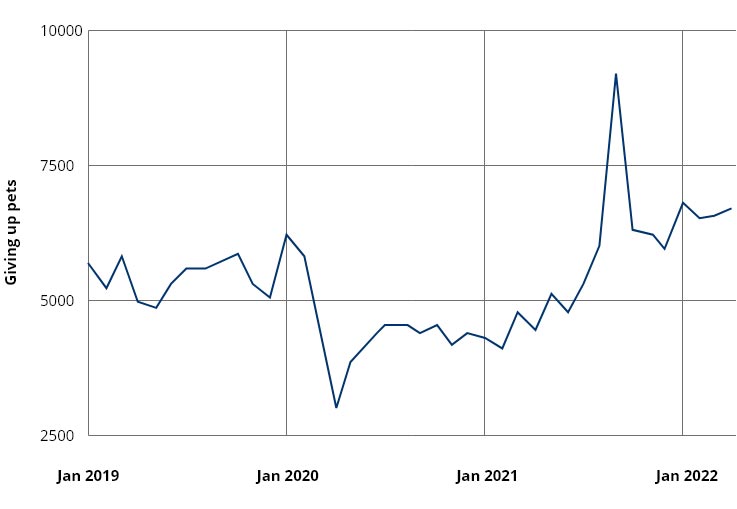
Rising volumes of rehoming search data are consistent with trends experienced by the RSPCA. The spike in September 2021 of this upward trend coincided with the return back to school, lockdown restrictions easing and many pets that were bought in the first lockdown in 2020 coming of age, needing neutering and perhaps displaying different behaviour such as refusing commands.
The 2021-2022 Christmas period alone saw abandonments rise by 29% from the previous year with 1,478 reports of abandoned animals to the RSPCA compared to 1,049 the previous year. Similar patterns have been reported by the Scottish SPCA in relation to puppies where the number of calls to our emergency line and incidents have increased.
We are worried about the indications that this trend is increasing. For example, in 2020, 672 rabbits came into the RSPCA's care. This rose by 28% to 859 in 2021 and we are worried about it rising further in 2022. The latest figure for January to April 2022 was 285. This has coincided with a decrease in the number of people wanting to rehome rabbits from over 2,700 in 2018 to 2,080 in 2020. This trend with rabbits is also seen by the Scottish SPCA.
Under immense pressure, the UK Government announced a £15 billion package of support for households to cope with rising living costs in May 2022. The package will certainly provide temporary relief and timely support for many households faced with significant hardship, the Institute for Fiscal Studies (IFS) says, but income and spending volatility remains the norm for too many.
Although the Government's package aims to curb the sharp increases in day-to-day household costs, there remain underlying challenges of rising child poverty rates, increase in food bank use and demand for debt support services outstripping supply.
Many households don't have enough savings to withstand a financial shock, for example coping with a family illness, changes in working hours or even a washing machine breaking down.
And it is within this context that we are concerned about the welfare of animals.
Our polling work took place just before the Government's relief package was announced and paints a worrying picture.
For many, the cost of looking after their pet is rising
Pet owners are not exempt from the pressures on household finances. For over two-thirds of pet owners (68%), it is more expensive to look after their pet now compared to last year(Figure 10). In reality that means that costs have increased for an estimated 18.5 million pet owners.
For about half of these pet owners (52%), it is slightly more expensive; but for 16% it is much more expensive. A quarter (26%) say there is no difference and a small minority (2%) find it less expensive.
Figure 10: How the cost of looking after their pet has changed in the past 12 months

These increased expenses directly translate into concerns about pet owners looking after and feeding pets (Figure 11).
- 19% are worried about feeding their pets. There has also been a noticeable rise in the number of related Google searches in the UK. In 2019, the average number of searches for 'pet food cost' was 3,600; in 2020 and 2021, it averaged at about 5,000 searches a month. So far in 2022, it has increased to 5,140 per month.
- 28% of pet owners are worried about being able to care for their pets. This concern is especially high among cat owners, a third (32%) of whom are worried about being able to care properly for their pet. Dog owners are no more or less likely to be concerned than pet owners overall.

Responding to concern over being able to feed and take care of pets, we began joining forces with local food banks in 2020.
Thanks to a generous donation by the Pets At Home Foundation in 2022, we've been able to extend this to help even more pet owners who are struggling.
Building on existing schemes run by many RSPCA centres and branches, the new Pet Food Bank Partnership sees over 20 more teaming up with their local food banks across the north of England. The scheme aims to reach 110 food banks by the end of next year to provide help to the public and reduce animal abandonment. In the first quarter of 2022, the RSPCA distributed double the amount of pet food than the previous year to help meet demand.
So far this year, between January and May, the partnership has delivered over 100 pet food bundles to its food banks across the north of England, including 51 in Lancashire (where the project began). But more food is now desperately needed.
Understandably, concern about cost and looking after pets is linked to income.
Those in lower household income bands are more likely to be worried compared to those in the higher income bands.
Almost two-fifths (39%) of those with a household income of under £20,000 a year are worried about being able to care properly for their pet compared to just under one-fifth (18%) of those with a household income of £60,000 and above.
'Does my pet need a vaccination' and 'cheap vets near me' are more commonly being searched
Observations of Google search data mirrors these concerns, heightening our worries about the wellbeing of pets in the UK. We have looked at volumes of search terms in the UK from before the coronavirus pandemic and throughout the pandemic, and what's happening in 2022 so far. It may be too early in many cases to identify whether trends will revert back to pre-pandemic levels. But drawing on these real-time data, provides us with opportunities to better support our members, the public and animals.Ways to reduce the costs of having a pet generate persistently high volumes of searches. The most frequent of these searches is around pet vaccination costs (Figure 12).
Overall there has been a steady upwards trend, peaking in August 2021, with over 23,000 searches a month for pet vaccination costs. In 2022, the average is about 17,000, far higher than volumes pre-pandemic in 2019.
Figure 12: Pet vaccination costs

A similar trend, although with lower volumes, is found with the search term 'cheap vets near me' (Figure 13).
Before coronavirus, in 2019, this term had an average of 2,350 searches a month. Search volumes rose with a significant spike in the summer 2021 where there were more than 5,000 monthly searches. So far in 2022, searches have been more steady, averaging at about 3,330 per month.
Figure 13: Cheap vets near me

Linked to searches seeking help for sick animals, we have also seen a sensational rise in Google searches for terms such as 'can I give my dog paracetamol', suggesting that people are trying to treat their pets at home (Figure 14). In 2019, before coronavirus, the average number of monthly searches were 15,753. By 2021, the average number of monthly searches had more than doubled to over 35,000 per month. In April 2022, there were a staggering 39,840 searches - the highest recorded to date.
Figure 14: Can I give my dog paracetamol?
 Increases in these kinds of searches also point to people accessing varied information. Although the most common place for pet owners to seek advice from is vets, survey data also found that about half looked online (49%) when seeking advice and information; with 44% looking online in general and 12% looking on social media. Again this raises concern that many may be pushed through to information of mixed quality and may not always receive the most accurate information or advice.
Increases in these kinds of searches also point to people accessing varied information. Although the most common place for pet owners to seek advice from is vets, survey data also found that about half looked online (49%) when seeking advice and information; with 44% looking online in general and 12% looking on social media. Again this raises concern that many may be pushed through to information of mixed quality and may not always receive the most accurate information or advice. Another noticeable rise has been for help with vet bills. In April 2020, there were approximately 4,000 monthly searches for related terms. So far in 2022 there are just under 6,000 a month. Nearly 600 of these are specifically looking for RSPCA support with bills; and another 600 explicitly look for help with vet bills on benefits. This is consistent with call volumes to our emergency and cruelty line where in 2021 the RSPCA received 3,644 calls categorised as 'help with vet bills'.
This is an increase of 12% from the year before where 3,241 calls were received.
Presenting search data can lead to a number of different interpretations. It could be that the data presented simply reflect new pet owners getting to grips with their new responsibilities; but combined with other findings from the survey, we are concerned that they are an indication of struggles to afford what pets need to thrive.
We're worried about pets
Our concern deepens when we explore the relationship between buying new animals and abandonment. RSPCA and Scottish SPCA experience suggests that there is a link between increased pet ownership and increased levels of abandonment. It is often the result of a mismatch between owners' expectations and the reality of looking after a pet.In the polling results, approximately a third of pet owners found something surprising about looking after a pet. The most common surprises were restrictions on personal freedom, cited by about a third (34%), or unexpected behavioural issues, cited by over a quarter (27%).
Dog owners are especially likely to say that they found the restrictions on personal freedom to be more than they expected; and are also likely to say that behavioural issues have been more difficult compared to other pet owners.
These findings are in tension with other survey results that point to a large number of people recognising that dogs feel and express emotions (Figure 20), and sentiments from the RSPCA's Dogkind report where again there were high levels of people recognising the range of emotions that dogs feel, but challenges for dog owners to translate those attitudes into positive pet-owning behaviour.
The difficulties in translating attitudes into behaviours then as now are most likely to be because owners are busy, have a lack of awareness of what to do, or the cost of seeking solutions can be a hurdle or prohibitive. It is possible that as the lockdown eased, activities like walking and spending time with a dog became more difficult with the return of going to work.
Another way to explore the mismatch of expectations is to look at information on buying and rehoming animals.
Lockdown puppies and kittens
Not long ago, images of lockdown puppies and kittens flooded social media and family WhatsApp groups. Google search data validates this. The puppy trade is reported to be worth over £13 million every year in Scotland alone.
We explored Google search volumes of people looking to buy pets and observed that all of the animals we looked at were searched for in higher volumes over the coronavirus pandemic. Searches for turtles, dogs and cats have now returned to their pre-pandemic levels with the most recent month of data (April 2022).
Search volumes for the past 3 months (Feb 2022- Apr 2022) looking to buy dogs, cats, and some exotic pets receive:
- Dog - approx 3 million searches per month
- Cat - approx 500,000 searches per month
- Parrots - approx 70,000 searches per month
- Tortoise - 30,000 searches per month
- Python - 20,000 searches per month
- Bearded dragons - 13,000 searches per month
- Turtle - 13,700 / month
These 'spikes' in searches for axolotls to buy, correlating with gaming trends could demonstrate how a trend in a particular demographic or interest group can have very significant impacts on animals.
Similar to the growth in searching to buy animals, there has also been a steady rise in searches to give animals up.
Search terms relating to giving up pets currently total around 6,600 per month. This is an increase from around 4,400 in 2021 (Figure 15).
The most common search terms used are:
- Rehome my dog
- Giving up a dog
- How do I rehome my dog
- Give up dog for adoption

Rising volumes of rehoming search data are consistent with trends experienced by the RSPCA. The spike in September 2021 of this upward trend coincided with the return back to school, lockdown restrictions easing and many pets that were bought in the first lockdown in 2020 coming of age, needing neutering and perhaps displaying different behaviour such as refusing commands.
The 2021-2022 Christmas period alone saw abandonments rise by 29% from the previous year with 1,478 reports of abandoned animals to the RSPCA compared to 1,049 the previous year. Similar patterns have been reported by the Scottish SPCA in relation to puppies where the number of calls to our emergency line and incidents have increased.
We are worried about the indications that this trend is increasing. For example, in 2020, 672 rabbits came into the RSPCA's care. This rose by 28% to 859 in 2021 and we are worried about it rising further in 2022. The latest figure for January to April 2022 was 285. This has coincided with a decrease in the number of people wanting to rehome rabbits from over 2,700 in 2018 to 2,080 in 2020. This trend with rabbits is also seen by the Scottish SPCA.
Purchasing power
The cost of living crisis is influencing and limiting many decisions for households and businesses. Increasingly, cost and sustainability are linked. Sharp rises in energy prices continue to spark debate on energy efficiency and national dependence on energy sources; and moves to encourage consumers to recycle and reuse to save money and save the planet are more mainstream.
These polling results provide another angle and perspective on this relationship, exploring attitudes towards environmental issues and animal welfare.
The welfare of animals is firmly connected to the fate of the environment. Respondents were asked how much of a negative impact different environmental issues have on animal welfare in the UK. The results suggest a strong recognition and correlation of the negative impact of environmental issues on animal welfare.
All the issues listed were recognised by a majority of respondents as having either a very large or a fairly large impact on animal welfare, with 4 out of 5 respondents citing water pollution (81%) and deforestation (80%) as having a particularly large impact on animal welfare (Figure 16).
Figure 16: how much of a negative impact respondents think environmental issues have on animal welfare in the UK
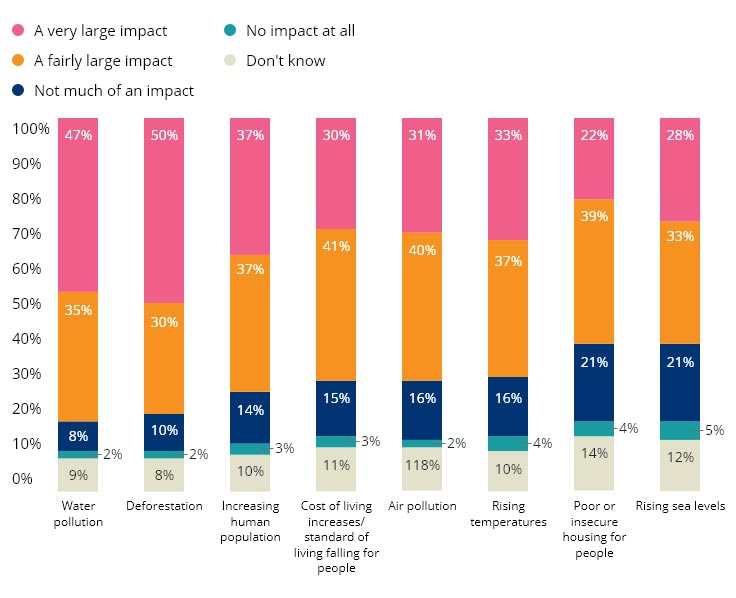
Women are more likely to report that every issue listed has a large impact on animal welfare, with the exception of increasing human population where almost three quarters (74%) of both men and women think that it does. This links to earlier findings that women are more interested in animal welfare and suggests that, as a result, women may be more knowledgeable about how the environment impacts animal welfare than men.
Unsurprisingly those who follow a vegetarian or pescatarian diet are more likely to say that animal welfare standards impact their dietary habits. While 83% of vegetarians and 71% of pescatarians report that it influences them to a great extent or somewhat, only six in ten (60%) of meat eaters say the same.
Almost two-thirds consider animal welfare standards in their dietary choices to a great extent or somewhat.
Figure 17: extent to which different factors influence diet choices
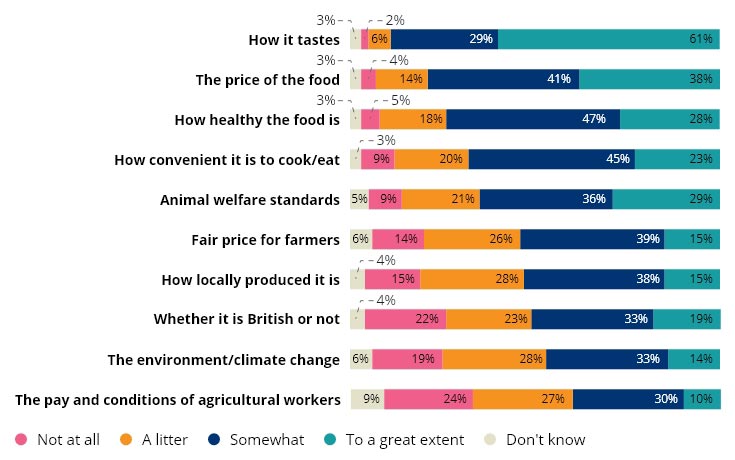
Unsurprisingly, those who follow a vegan or vegetarian diet are more likely to say that animal welfare standards are influential in their dietary choices; 84% of vegans and 73% of vegetarians report this compared to just 37% of meat eaters. Those who describe themselves as animal lovers are also more likely to say that they are influenced by the environmental impact of the food that they eat.
Polling found that two-thirds (66%) consider animal welfare in their dietary choices (Figure 17), and almost a third (31%) have eaten less meat or stopped eating meat in the last year to support animals (Figure 5).
In addition, research for RSPCA Assured in 2021 undertaken by Clarasys estimates that about a quarter of the public are considering reducing their meat consumption and about a fifth already have, demonstrating again that there is a sizable group wanting to take action.
The Eating Better coalition is a group of 60 organisations trying to support people to reduce their meat and dairy consumption for a more sustainable future. As part of this, the RSPCA highlights the big and small steps that individuals, households, retailers, the food industry and the Government can take to bring about change.
Interestingly, there was no evidence in the survey that considering animal welfare standards in diets is connected to income. Survey results revealed that those with lower household incomes are just as likely to say that animal welfare standards significantly influence their decision as those with higher incomes.
Roughly two-thirds of each income group report that animal welfare standards influence their diets to a great extent or somewhat: 64% of those with a household income of under £20,000 a year and 67% of those with a household income of £60,000 a year or more.
On the surface, this suggests that people are not being put off buying food products with higher animal welfare standards because they cannot afford it. Translating that into consumer decisions, especially at a time of high inflation and household budget crunches, tends to be more complicated.
Through RSPCA Assured, we continue to advocate for high standards in line with the RSPCA welfare standards. The relationship works in different ways; customers' expectations are rising, and retailers are responding. At the same time, retailers can lower the price to drive up demand. Change often requires both these things to happen. And they are.
For example:
Consumer decisions, especially about diet, are complicated. The survey provides a snapshot at a time of significant pressure on household budgets.
Cutting down on animal products, driving up welfare standards and keeping prices competitive is a delicate balance - but one that cautiously resonates with the public.
As Dr Jane Goodall DBE said in the RSPCA's recently published collection of essays, What Have Animals Ever Done For Us, "We can all make small - and sometimes big - changes to our lifestyles, and to our eating and shopping habits."
Overall, between a quarter and a third cite ethical factors as important. Just over a quarter (26%) say that the impact on animal welfare is important to their investment decisions. Again, the results suggest that generally women are more conscious of the social and environmental impact of their investments than men.
Figure 18: important factors in choosing stocks and shares or funds to invest in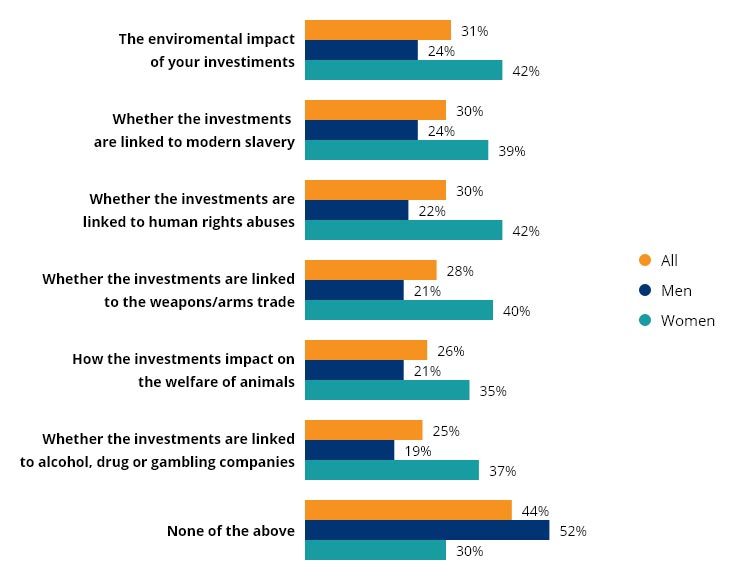
Grey, pink, purple and green pounds already exist and are well known to retailers and advertisers (Figure 19). They refer to the disposable income of different population groups and the potential spending power for particular products and in particular sectors.
With the wider and growing awareness of animal welfare issues, there is an opportunity to quantify and campaign for an animal pound.
Figure 19: scope for an animal pound
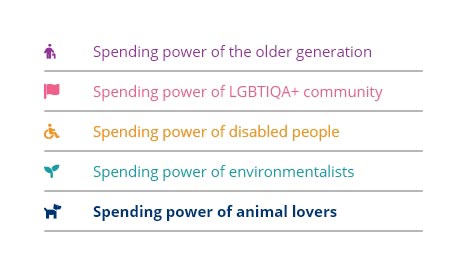
A number of opportunities already exist to determine the value of the animal pound within the ethical investment and pensions space:
Gaining the next layer of understanding on the potential of these opportunities, for example by undertaking an animal welfare audit of existing ESG policies and exploring the potential market of the animal pound are constructive ways to translate this desire into action. It could unlock untapped potential in generating financial returns for individuals and organisations.
These polling results provide another angle and perspective on this relationship, exploring attitudes towards environmental issues and animal welfare.
The welfare of animals is firmly connected to the fate of the environment. Respondents were asked how much of a negative impact different environmental issues have on animal welfare in the UK. The results suggest a strong recognition and correlation of the negative impact of environmental issues on animal welfare.
All the issues listed were recognised by a majority of respondents as having either a very large or a fairly large impact on animal welfare, with 4 out of 5 respondents citing water pollution (81%) and deforestation (80%) as having a particularly large impact on animal welfare (Figure 16).
Figure 16: how much of a negative impact respondents think environmental issues have on animal welfare in the UK

Women are more likely to report that every issue listed has a large impact on animal welfare, with the exception of increasing human population where almost three quarters (74%) of both men and women think that it does. This links to earlier findings that women are more interested in animal welfare and suggests that, as a result, women may be more knowledgeable about how the environment impacts animal welfare than men.
Unsurprisingly those who follow a vegetarian or pescatarian diet are more likely to say that animal welfare standards impact their dietary habits. While 83% of vegetarians and 71% of pescatarians report that it influences them to a great extent or somewhat, only six in ten (60%) of meat eaters say the same.
Animal welfare standards and dietary choices
Respondents were asked to what extent different factors influence the food that they eat. The most significant factor is taste, with the vast majority saying this influences the food they eat to a great extent (61%) or somewhat (29%). Price is the next most significant factor, with almost eight in ten (79%) reporting this influencing their choices to a great extent or somewhat (Figure 17).Almost two-thirds consider animal welfare standards in their dietary choices to a great extent or somewhat.
Figure 17: extent to which different factors influence diet choices

Unsurprisingly, those who follow a vegan or vegetarian diet are more likely to say that animal welfare standards are influential in their dietary choices; 84% of vegans and 73% of vegetarians report this compared to just 37% of meat eaters. Those who describe themselves as animal lovers are also more likely to say that they are influenced by the environmental impact of the food that they eat.
Polling found that two-thirds (66%) consider animal welfare in their dietary choices (Figure 17), and almost a third (31%) have eaten less meat or stopped eating meat in the last year to support animals (Figure 5).
In addition, research for RSPCA Assured in 2021 undertaken by Clarasys estimates that about a quarter of the public are considering reducing their meat consumption and about a fifth already have, demonstrating again that there is a sizable group wanting to take action.
The Eating Better coalition is a group of 60 organisations trying to support people to reduce their meat and dairy consumption for a more sustainable future. As part of this, the RSPCA highlights the big and small steps that individuals, households, retailers, the food industry and the Government can take to bring about change.
Interestingly, there was no evidence in the survey that considering animal welfare standards in diets is connected to income. Survey results revealed that those with lower household incomes are just as likely to say that animal welfare standards significantly influence their decision as those with higher incomes.
Roughly two-thirds of each income group report that animal welfare standards influence their diets to a great extent or somewhat: 64% of those with a household income of under £20,000 a year and 67% of those with a household income of £60,000 a year or more.
On the surface, this suggests that people are not being put off buying food products with higher animal welfare standards because they cannot afford it. Translating that into consumer decisions, especially at a time of high inflation and household budget crunches, tends to be more complicated.
Through RSPCA Assured, we continue to advocate for high standards in line with the RSPCA welfare standards. The relationship works in different ways; customers' expectations are rising, and retailers are responding. At the same time, retailers can lower the price to drive up demand. Change often requires both these things to happen. And they are.
For example:
- Despite income pressures during the coronavirus pandemic, sales of RSPCA Assured products grew by 26% in 2021.
- Insight from RSPCA Assured is seeing significant increase in sales of higher welfare indoor chickens, as customers trade down from more premium lines, but continue to prioritise welfare.
- Co-op, Sainsbury's, M&S, Waitrose & Partners and Tesco, who represent over half the market share, have all signed up to the WWF's Basket Metric that commits to all their meat being a 'better level' by 2030.
- Over 200 companies across the food industry in Europe signed up to the Better Chicken Commitment to increase welfare standards across the industry.
Consumer decisions, especially about diet, are complicated. The survey provides a snapshot at a time of significant pressure on household budgets.
Cutting down on animal products, driving up welfare standards and keeping prices competitive is a delicate balance - but one that cautiously resonates with the public.
As Dr Jane Goodall DBE said in the RSPCA's recently published collection of essays, What Have Animals Ever Done For Us, "We can all make small - and sometimes big - changes to our lifestyles, and to our eating and shopping habits."
Pensions and investments
Those with pensions and investments can now make more informed choices about what impact, if any, these can have on social and environmental issues. Of those surveyed, 14% have a pension or investment product in which they control where the money is invested. We asked these respondents a follow up question to determine which factors, if any, were important to them in deciding where their money is spent (Figure 18).Overall, between a quarter and a third cite ethical factors as important. Just over a quarter (26%) say that the impact on animal welfare is important to their investment decisions. Again, the results suggest that generally women are more conscious of the social and environmental impact of their investments than men.
Figure 18: important factors in choosing stocks and shares or funds to invest in

Connecting the dots: an animal pound
- A quarter (26%) of existing pension or investment holders consider the impact on animal welfare in their decisions
- A majority of respondents recognise the negative impact of environmental factors on animal welfare
- Over three quarters (78%) of people think that individuals should take responsibility
- Three quarters (75%) take action to help animals
Grey, pink, purple and green pounds already exist and are well known to retailers and advertisers (Figure 19). They refer to the disposable income of different population groups and the potential spending power for particular products and in particular sectors.
With the wider and growing awareness of animal welfare issues, there is an opportunity to quantify and campaign for an animal pound.
Figure 19: scope for an animal pound

A number of opportunities already exist to determine the value of the animal pound within the ethical investment and pensions space:
- Since pension auto-enrolment began for every employee in 2018, the vast majority of UK employees now have a private pension in addition to their state pension. This provides an opportunity to promote decisions that will benefit animal welfare for individuals, providers, and sectors.
- Since 2018, the Department for Work and Pensions has regulated that trustees have to have a policy on their Environmental, Social and Governance (ESG) approach. And despite slow progress to date, it does suggest that there are growing opportunities to influence investment decisions and behaviour at both individual and corporate levels.
Gaining the next layer of understanding on the potential of these opportunities, for example by undertaking an animal welfare audit of existing ESG policies and exploring the potential market of the animal pound are constructive ways to translate this desire into action. It could unlock untapped potential in generating financial returns for individuals and organisations.
Animals have feelings too
Sentience means the ability to experience positive and negative feelings, such as pleasure, joy, pain and distress, that matter to the individual. Our research shows that there may be a positive relationship between people's knowledge of and experience with an animal and their perception of its sentience. This is likely to be one factor among many.
In a list of eight different animals, some commonly known and others less well known, the vast majority (92%) considered dogs to be sentient (Figure 20).
Other findings included:
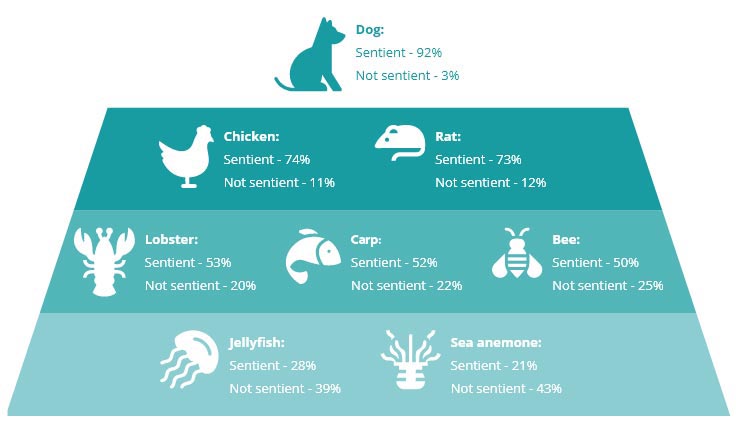
Although chickens, rats, lobsters and carp were less likely to be considered sentient, these are all legally recognised as such in the UK, based on scientific evidence. Bees are also included in some other national animal welfare laws.
Given the gap between the public's perception of sentience and the scientific consensus, we will continue to advocate for the application of the 'precautionary principle'. Simply, this means that we should err on the side of caution and give animals the benefit of the doubt when the evidence is inconclusive. The recent developments regarding decapod crustaceans (crabs, lobsters and shrimp) validate this approach. These animals are now included in the new Animal Welfare (Sentience) Act 2022 , which is the first UK law to recognise that they are sentient. This came about because a research team found that there is now adequate evidence that decapod crustaceans can experience pain and distress.
Currently jellyfish and sea anemone are not considered sentient by the science; but with a significant minority assigning greater sentience than is supported by the science, it gives us further reason to support the 'precautionary principle.'
Most people think that dogs can experience all of the emotions listed - from a high of almost nine in ten saying dogs can experience fear or happiness (both 86%) to just over half thinking dogs feel guilt (53%). These findings echo the RSPCA's Dogkind report where we saw similar levels of recognising the range of emotions that dogs feel.
Unsurprisingly, dog owners are more likely than non-dog owners to think dogs feel the listed emotions. Around nine in ten dog owners say dogs feel love towards people (91%), boredom (89%), or sadness (89%).
And while less than three quarters of non-dog owners think dogs feel jealousy (71%) or worry (67%), this rises to 85% and 82% respectively of dog owners.
The difference between owners and non-owners is even more pronounced when considering rats' feelings. Over half of small mammal owners say rats can experience happiness (58%) compared to just a third of those without pets in their household (31%).
Similarly, only a fifth of non-owners think rats can experience love towards people (19%) - a figure which doubles amongst small mammal owners (51%).
Figure 21: The proportion who think dogs and rats can experience the following feelings
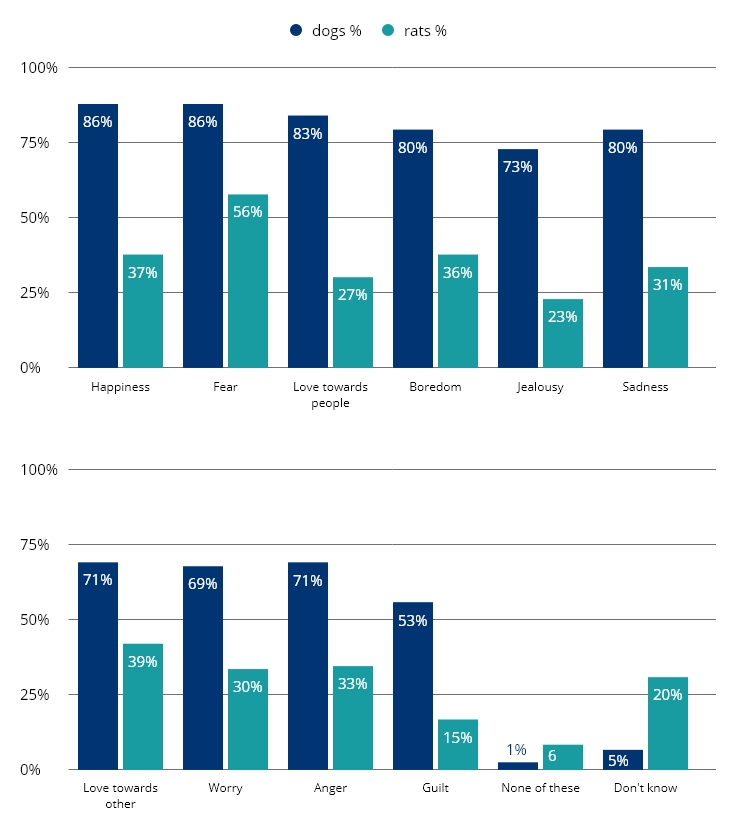
The differences between people's perceptions of the emotions dogs and rats experience is stark, with the difference perhaps explained by people generally being more familiar with dogs compared to rats, and rats' characterisation as 'vermin' or 'pests'. This again highlights the relationship between familiarity of an animal and perception of their ability to feel.
Our relationship with animals can be fundamentally altered by greater experience, education and understanding. Educating the public about the range of emotions that animals - not just pets - experience is important. The RSPCA and Scottish SPCA will take that on as a lesson emerging from this research. Also crucial to making that happen is addressing the public's desire to see animal welfare as part of the school curriculum by increasing familiarity and knowledge that animals have feelings too.
In a list of eight different animals, some commonly known and others less well known, the vast majority (92%) considered dogs to be sentient (Figure 20).
Other findings included:
- around three quarters of the respondents considered chickens (74%) and rats (73%) to be sentient
- and about half consider lobsters (53%), carp (52%) and bees (50%) to be sentient
- a minority of the public think that jellyfish (28%) or sea anemones (21%) are sentient.

Although chickens, rats, lobsters and carp were less likely to be considered sentient, these are all legally recognised as such in the UK, based on scientific evidence. Bees are also included in some other national animal welfare laws.
Given the gap between the public's perception of sentience and the scientific consensus, we will continue to advocate for the application of the 'precautionary principle'. Simply, this means that we should err on the side of caution and give animals the benefit of the doubt when the evidence is inconclusive. The recent developments regarding decapod crustaceans (crabs, lobsters and shrimp) validate this approach. These animals are now included in the new Animal Welfare (Sentience) Act 2022 , which is the first UK law to recognise that they are sentient. This came about because a research team found that there is now adequate evidence that decapod crustaceans can experience pain and distress.
Currently jellyfish and sea anemone are not considered sentient by the science; but with a significant minority assigning greater sentience than is supported by the science, it gives us further reason to support the 'precautionary principle.'
Are there differences between dogs' and rats' feelings?
Thinking more in-depth about how animals might experience emotions, respondents were asked what feelings they think dogs and rats can have. Presented with a range of emotions, people are more likely to think that dogs experience all of them than rats (Figure 21).Most people think that dogs can experience all of the emotions listed - from a high of almost nine in ten saying dogs can experience fear or happiness (both 86%) to just over half thinking dogs feel guilt (53%). These findings echo the RSPCA's Dogkind report where we saw similar levels of recognising the range of emotions that dogs feel.
Unsurprisingly, dog owners are more likely than non-dog owners to think dogs feel the listed emotions. Around nine in ten dog owners say dogs feel love towards people (91%), boredom (89%), or sadness (89%).
And while less than three quarters of non-dog owners think dogs feel jealousy (71%) or worry (67%), this rises to 85% and 82% respectively of dog owners.
The difference between owners and non-owners is even more pronounced when considering rats' feelings. Over half of small mammal owners say rats can experience happiness (58%) compared to just a third of those without pets in their household (31%).
Similarly, only a fifth of non-owners think rats can experience love towards people (19%) - a figure which doubles amongst small mammal owners (51%).
Figure 21: The proportion who think dogs and rats can experience the following feelings

The differences between people's perceptions of the emotions dogs and rats experience is stark, with the difference perhaps explained by people generally being more familiar with dogs compared to rats, and rats' characterisation as 'vermin' or 'pests'. This again highlights the relationship between familiarity of an animal and perception of their ability to feel.
Our relationship with animals can be fundamentally altered by greater experience, education and understanding. Educating the public about the range of emotions that animals - not just pets - experience is important. The RSPCA and Scottish SPCA will take that on as a lesson emerging from this research. Also crucial to making that happen is addressing the public's desire to see animal welfare as part of the school curriculum by increasing familiarity and knowledge that animals have feelings too.
Conclusion
Our Animal Kindness Index reveals that a large proportion of UK people are committed to animal welfare. They love animals, they want our governments to keep them safe. And they understand that protecting animals means protecting the environment - and vice versa. But our research also confirms that the increasing cost of living is a risk to animal welfare, making people less able to provide for their pets.
Animal welfare is now a mainstream issue. Our findings support the idea that it's fundamental to solving many of the social, economic and environmental challenges we all face. Just as our understanding of animals shapes our behaviour towards them, so too our attitudes towards animal welfare contribute to wider issues like inequality and climate change.
Overall, it's good news. We are a nation who will take action for animals and expect governments to step up too. Our Animal Kindness Index gives us strong foundations to build on - and many reasons to be optimistic about what we can achieve, together, for animal welfare.
As a nation, our intentions are to be kind.
Animal welfare is now a mainstream issue. Our findings support the idea that it's fundamental to solving many of the social, economic and environmental challenges we all face. Just as our understanding of animals shapes our behaviour towards them, so too our attitudes towards animal welfare contribute to wider issues like inequality and climate change.
Overall, it's good news. We are a nation who will take action for animals and expect governments to step up too. Our Animal Kindness Index gives us strong foundations to build on - and many reasons to be optimistic about what we can achieve, together, for animal welfare.
As a nation, our intentions are to be kind.
